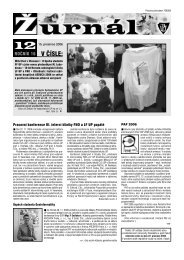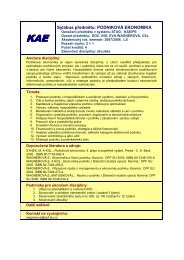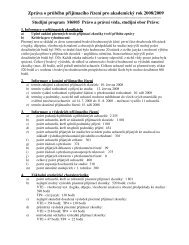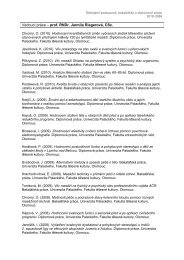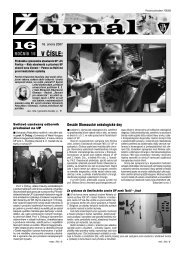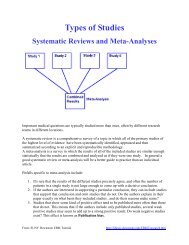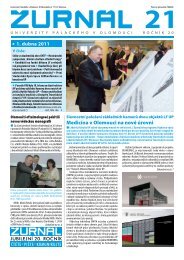ACTA UNIVERSITATIS PALACKIANAE OLOMUCENSIS GYMNICA ...
ACTA UNIVERSITATIS PALACKIANAE OLOMUCENSIS GYMNICA ...
ACTA UNIVERSITATIS PALACKIANAE OLOMUCENSIS GYMNICA ...
- No tags were found...
You also want an ePaper? Increase the reach of your titles
YUMPU automatically turns print PDFs into web optimized ePapers that Google loves.
24 Acta Univ. Palacki. Olomuc., Gymn. 2004, vol. 34, no. 2Fig. 4The curve of the back in girls in particular age groups90%807060504030201007 8 9 10 11 12 13 14 15agenormal back round back flat backposture varies from 29% at 12 years of age to the highestpercentage found at the age of 13 with 44% of girls.For more detailed information on the relationshipbetween age and posture, the statistical level ofsignificance was analyzed using the Pearson’s correlationcoeffi cient to fi nd out the relationship betweenthe dependence between the two quantities. Testingwas carried out at the statistical level of signifi canceof 0.05. The calculated correlation coefficient, used fortesting each age group of a certain sex in relationship toparticular posture categories, did not confirm a significantrelationship between the age group and the posturecategory. Posture in boys and girls within this age rankprobably does not depend on age.When examining posture, we also evaluated theposture of individual body parts in sagittal and frontalplanes. In the sagittal plane, the thorax spine archwas evaluated within three levels: the spine is slightlykyphotic = normal back, the spine shows slight deviationsand significant bending in this part = round back(this group includes probands whose curve of the backwithin the thorax part is evaluated by the degree of 2, 3or 4 in accordance with the Jaroš & Lomíček method),and with a lack of normal curve = flat back. The assessmentof the thorax spine curve is shown in TABLE 3and Fig. 3, 4.The high percentage of round backs found in nearly53% of boys and 75% of girls imply the occurrence ofmuscular dysbalances in this area that is called “uppercross syndrome” in the literature. Janda (1982) describesthis syndrome as a typical occurrence of muscular dysbalancesbetween the shortened postural muscles onthe front side of the thorax (major pectoral and minorpectoral muscles), and on the rear side of the thorax,the slackened phasic muscles, namely shoulder blademuscles (trapezius, rhomboid muscles), back musclesand trunk erectors and also between deep neck flexorson one side and neck extensors on the other side. Theseresults in keeping the head forward, keeping shouldersraised and stuck forward and the abduction locomotivestereotype in the shoulder joint is negatively affected.To a certain extent, this fact is supported by the findingof outstanding shoulder blades as a consequence of theabove-mentioned slackening of shoulder blade musclesthat was found in 84% of boys and 67.4% of girls.The high percentage of round backs in girls is causedby a kind of shyness connected with the period of adolescenceand the growth of breasts, which is evidencedby a gradual increase in the occurrence of round backsin girls within the age group of 12 to 15 years.The assessment of the curve of the back in the sagittalplane using the tangent let fall from protuberantiaoccipitalis shows the depth of the bend in the areaof the cervical and lumbar lordosis. In probands notranked within the category I – perfect posture, thedepth of the cervical and lumbar lordosis varied withinthe limits stated by Srdečný et al. (1982) and Kryštofič(2000). In this category, the cervical lordosis variedwithin 2.5–3 cm and the lumbar lordosis within 3–3.5 cm.Probands ranked within the category II – nearly perfectposture and had an average depth of cervical and lumbarlordosis within 4 to 5 cm. The largest depth of thecervical and lumbar lordosis was found in category III– defective posture. For both sexes, the average depth




